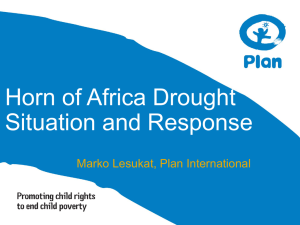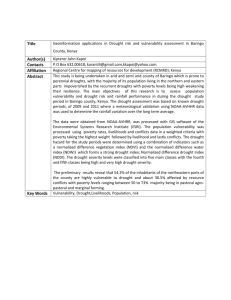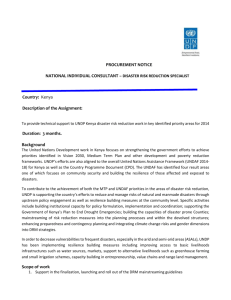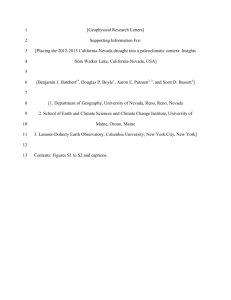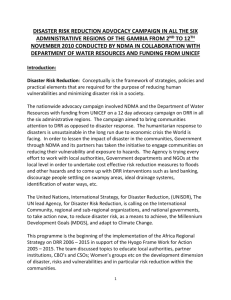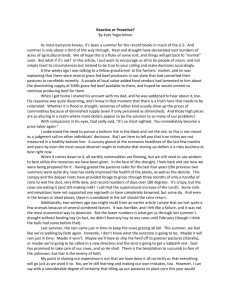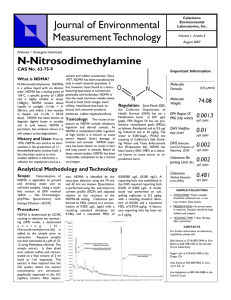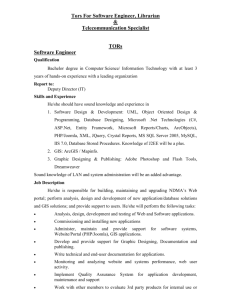Terms of Reference NATIONAL INDIVIDUAL CONSULTANT
advertisement
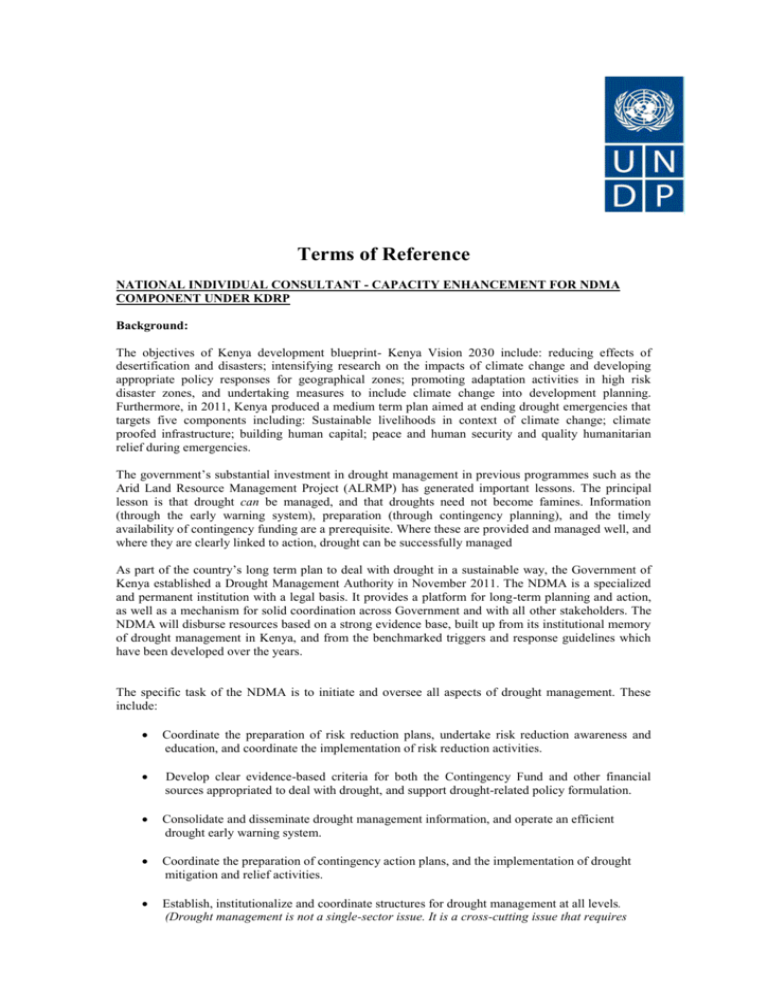
Terms of Reference NATIONAL INDIVIDUAL CONSULTANT - CAPACITY ENHANCEMENT FOR NDMA COMPONENT UNDER KDRP Background: The objectives of Kenya development blueprint- Kenya Vision 2030 include: reducing effects of desertification and disasters; intensifying research on the impacts of climate change and developing appropriate policy responses for geographical zones; promoting adaptation activities in high risk disaster zones, and undertaking measures to include climate change into development planning. Furthermore, in 2011, Kenya produced a medium term plan aimed at ending drought emergencies that targets five components including: Sustainable livelihoods in context of climate change; climate proofed infrastructure; building human capital; peace and human security and quality humanitarian relief during emergencies. The government’s substantial investment in drought management in previous programmes such as the Arid Land Resource Management Project (ALRMP) has generated important lessons. The principal lesson is that drought can be managed, and that droughts need not become famines. Information (through the early warning system), preparation (through contingency planning), and the timely availability of contingency funding are a prerequisite. Where these are provided and managed well, and where they are clearly linked to action, drought can be successfully managed As part of the country’s long term plan to deal with drought in a sustainable way, the Government of Kenya established a Drought Management Authority in November 2011. The NDMA is a specialized and permanent institution with a legal basis. It provides a platform for long-term planning and action, as well as a mechanism for solid coordination across Government and with all other stakeholders. The NDMA will disburse resources based on a strong evidence base, built up from its institutional memory of drought management in Kenya, and from the benchmarked triggers and response guidelines which have been developed over the years. The specific task of the NDMA is to initiate and oversee all aspects of drought management. These include: Coordinate the preparation of risk reduction plans, undertake risk reduction awareness and education, and coordinate the implementation of risk reduction activities. Develop clear evidence-based criteria for both the Contingency Fund and other financial sources appropriated to deal with drought, and support drought-related policy formulation. Consolidate and disseminate drought management information, and operate an efficient drought early warning system. Coordinate the preparation of contingency action plans, and the implementation of drought mitigation and relief activities. Establish, institutionalize and coordinate structures for drought management at all levels. (Drought management is not a single-sector issue. It is a cross-cutting issue that requires collaborative action by a range of public and private sector agencies at different levels (national, county, and community). The establishment of NDMA provides an opportunity for the government and other stakeholders to address drought in a more sustainable manner. It is anticipated that the authority will play a central role in ensuring that the government puts in place the right policies, strategies and plans to deal with impacts of drought. Mainstreaming of drought into government budgeting and planning process and providing leadership and overall coordination will be central to the authority. However, being a new establishment, NDMA requires support in most of the areas to effectively discharge its mandate. The Authority is currently hiring staff that will work at different levels. In this regard, UNDP Kenya in partnership with Drylands Development Center (UNDP DDC) proposes to focus on knowledge and capacity development for the newly recruited staff. DDC is a centre of excellence dedicated to working with people to fight poverty in the drylands globally. Their experience and knowledge in some of the best practices will be invaluable for NDMA staff. (a) Objectives of the consultancy: To identify opportunities and capacity needs covering knowledge management and communication for the DRR division at headquarters, and information and resilience units at the county level based on which to provide training support. The consultant for the UNDP-DDC will conduct a similar exercise at the national level and in five other counties in the ASAL regions (b) Scope of work and expected output: The purpose of the capacity assessment is to identify capacity opportunities and gaps among the NDMA staff in five districts (Marsabit, Isiolo, Kajiado, Makueni and Malindi ) related to disaster risk reduction and early recovery, understand desired capacities and propose recommendation on how these capacities can be achieved. The service provider shall provide a clear and concrete capacity development recommendations proposed to address any gaps and challenges identified. The assessment will focus on the following key areas 1. Coordination of Disaster Risk Reduction and Early Recovery a. Information management, including early warning b. Hazard and vulnerability mapping c. Stakeholder mapping of roles and responsibilities d. Disaster preparedness and contingency planning e. Effective response and recovery 2. Governance of DRR a. Ability to support formulation of relevant policies b. Leadership and mutual accountability mechanism c. Standards and guidelines for DRR and ER d. Existing institutional arrangements (including District Stearing Groups and disaster management committees) e. Mainstreaming DRR and ER into key sectors and County plans 3. Capacity and competences in a. DRR and ER programming b. Advocacy for DRR and ER c. Climate change awareness 4. Working tools and resources for DRR and ER a. Existing working tools and frameworks b. Level of financial resources allocated for DRR and ER c. Human and physical resources 5. Stakeholders Analysis and relationships a. Map stakeholders and relationships for DRR and ER b. Public engagement Deliverables 1. Conception Report 2. Draft report for presentation to stakeholders including NDMA, UNDP, and government staff at the districts for validation. 3. A final report incorporating feedback from stakeholders shall be developed and presented to UNDP. 3 copies of bound report shall be presented. 4. Formulate capacity development programme. 5. Carry out one training event based on the identified capacity gaps. Duration of Assignment The assignment will take 8 calendar weeks. Reporting lines: The service provider will report to the Acting Chief Executive Officer of NDMA, but working closely with National Project Officer at NDMA. Administration arrangements 1. Arrangement for field visits and stakeholder meetings shall be arranged by NDMA. 2. The service provider is expected to provide his own equipment (computer etc) as well as physical facilities. Payment modalities Payment will be according to milestones agreed to during contract signing. Qualifications: A minimum of a Master degree in disaster management, development studies or relevant disciplines Minimum 5 years experience directly related to the field of disaster risk management, relief and recovery. Proven experience in undertaking capacity needs assessments and in developing tailoredmade training programmes Knowledge of international issues and frameworks related to DRR. Involvement in capacity building projects would be an asset. Working knowledge of government systems Fluency in English with excellent written and oral communication skills. Competencies Excellent report writing skills. Duty Station Nairobi with travel to Marsabit, Isiolo, Kajiado, Makueni and Malindi. Application Procedure Interested and qualified candidates should submit their application which should include the following: 1. Detailed Curriculum Vitae 2. UNDP Personal History Form (P11) ( template provided) 3. Proposal for implementing the assignment (template provided) Please quote “Capacity Enhancement - NDMA” on the subject line. Applications should be emailed to consultants.ken@undp.org to reach us not later than Friday, 22 March 2013 at 4.00 P.M Kenya Time.
